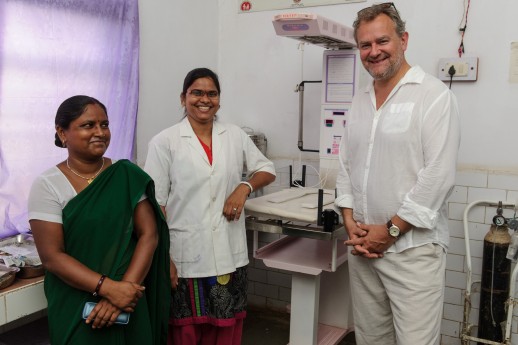Downton Abbey star’s exclusive diary from India
An edited version of this piece was published in Hello Magazine.
Actor Hugh Bonneville swapped Downton for Delhi to see first-hand the devastating impact a lack of clean water and good sanitation has on India’s poorest communities, and how WaterAid is working to transform lives.
Hugh, a WaterAid Ambassador, shares his exclusive diary about the trip with Hello!
I haven’t been to India since I went backpacking across the country in 1982, and I certainly didn’t go anywhere as remote as the places I’ll be visiting with WaterAid. So I’m looking forward, with some apprehension, to what I’m sure will be an eye-opening experience.
On the drive from Delhi to Agra, I am reminded of the heady mix of sights, sounds and smells I first experienced some three decades ago. Not to mention the wonderfully chaotic driving: slow cows in the fast lane, tuk-tuks beeping fast in the slow; everyone meandering towards their destination without traffic lights or, apparently, road rage.
The Taj Mahal, in Agra, is one of the most popular tourist attractions in the world, with around 400,000 visitors each year. However, on this trip, I will be seeing a very different side of this region, in a country full of contrasts.
With a population of over a billion, India is home to a third of the world’s poorest people. A staggering 776 million people in India don’t have access to adequate sanitation and 76 million have no safe water to drink. The crisis has a huge impact on health, with more than 140,000 children dying every year from preventable diarrhoeal diseases.
My first stop is Narai Ka Pura, a rural village in Madhya Pradesh, about two and a half hours from Agra. There is no access to clean water or toilet facilities here.
I am immediately struck by the mosquito-ridden, muddy, stagnant pools of water in the centre of the village. Despite the water levels apparently being lower than they were earlier in the week, we still have to balance on strategically-placed bricks and carefully walk along wooden planks in order to negotiate the flooded area. There are buffalo tied up here and there; their dung contributing to the detritus floating in the water and adding to the unsanitary conditions.
The village hand pump sits in the middle of all this, partly submerged in the filthy pools, which contaminate the water before it reaches the mouths of the community.
I am welcomed to the primary school – a modest building with two classrooms. Despite the rudimentary conditions, it’s fantastic to see such well-behaved kids!
Pradeep, a bright 10-year-old boy, shows me how they collect water from the hand pump, which is shared by the community of 300 people. He waits his turn before rolling his trousers up and wading through the murky water to the pump.
Tests have shown that the water here is contaminated with human waste. Pradeep knows the water isn’t clean and is often sick with diarrhoea, forcing him to miss school. He’s a keen student but with no other source available, he has no choice but to drink this unsafe water.
He then takes me to the outskirts of the village and points to the barley fields in the distance, explaining that this is where he goes to the toilet, where everyone goes to the toilet – women, men, and children, contributing to the spread of disease.
I try to picture my own son having to trek to a far off field in the middle of lessons in order to go to the toilet. I can’t, because he has never had to. These kids deserve better; their families deserve better.
I realise how much I take clean water and toilets for granted. Without these basic facilities, collecting water that isn’t even clean becomes a major preoccupation. Added to which, families in this village have to cope with the illnesses that are an inevitable by-product of a lack of such a vital resource.
This is a village that is crying out for the cycle of poverty to be broken. With some very simple changes, a brighter future lies ahead.
WaterAid is setting to work here soon. It will raise awareness of good hygiene practices and the importance of clean water and the need for proper toilets. Moreover, it will give them the means and know how to access government funding, so that they get the basic facilities that will change their lives, improving their health, their dignity and their prospects.
After a difficult visit, I’m keen to see how WaterAid has already helped to make a difference in the region.
Next, we visit Mahadev Pura, where some years ago WaterAid built a safe hand pump, ran hygiene awareness programmes and introduced household toilets, before handing over management of these facilities to the village.
The difference between the two communities is plain to see. Here in Mahadev Pura, the streets are well-constructed and spotless, with efficient drainage. Livestock are kept in one area of the village and the school is clean and well-organised.
There is a hand pump within the school grounds, solely for the students. It’s raised above the ground and therefore protected from surface-level contamination. There are separate toilets for boys and girls, as well as two handwashing stations.
Badri Prasad Rathore, who has taught at the school for 25 years, tells me that these facilities have transformed the lives of the students. Before, they had to bring water in from home and either go to the toilet in the field or near their homes, often not coming back to school afterwards. There were two tragic cases of children dying after being bitten by snakes when using the fields to relieve themselves.
Since the facilities have been introduced, the health, attendance and academic performance of the children have increased dramatically. The school is rightly proud of its achievement and I am invited to honour the statue of Sawaswati, the Hindu goddess of Education.
All the children here are taught the importance of hygiene and show me how they wash their hands properly to stay healthy. I meet members of the school’s Child Cabinet, which oversees issues such as cleanliness at the school. I join in with a playground game, its theme being hygiene – wash your hands and you can climb the giant board; defecate in the open and you’re sent back down. Of course, I let the kids win the game [cough].
The children not only apply these vital lessons in their daily lives but they’re also teaching their seniors within the family about the importance of good hygiene – ensuring that the generations work together for healthier, happier lives.
It’s fantastic to see the legacy of WaterAid; this village is living proof that simple changes in water supply, hygiene and sanitation really can bring a lasting transformation. Once the community started to see the tangible benefits, they took on the responsibility for improving their own lives and the community has gone from strength to strength.
They now have water, toilets and hygiene working together efficiently and above all, they have a common sense of purpose. When they get up in the morning, instead of risking their lives, they can turn on a tap knowing that clean water will come out of it. They can go to the toilet within their own home, rather than among the crops on which their community depends for food.
This snapshot of what this charity has done and is doing for these communities in India – and in 29 countries across the world – has intensified my admiration for what WaterAid is all about.
This week WaterAid has launched the Deliver Life appeal, which aims to reach 130,000 mothers, and their families, around the world with safe water.
I support WaterAid through a monthly donation and I hope you might consider doing so too. Or perhaps a one-off donation. It costs just £15 to give one person clean, safe water, but its impact is immeasurable.
Every £1 donated to WaterAid’s Deliver Life appeal between 10th November and 10th February will be doubled by the UK Government – meaning we can help twice as many mothers and babies stay safe and well. Find out more at deliverlife.wateraid.org









